What is feed corn, how is it grown and where is it used?
Global corn grain production in 2018 was approximately 960 million tons, and volumes continue to increase. Two thirds of the gross crop harvest is spent on feed for farm animals and poultry.
What is the difference between fodder corn and food, we will talk about the advantages and disadvantages of feeding livestock with corn in the article.
What is feed corn
Feed corn is a group of varieties that are unpretentious to growing conditions, but have reduced taste. The grain of such plants is used as a nutritious and inexpensive feed for farm animals: cattle, pigs, and poultry.
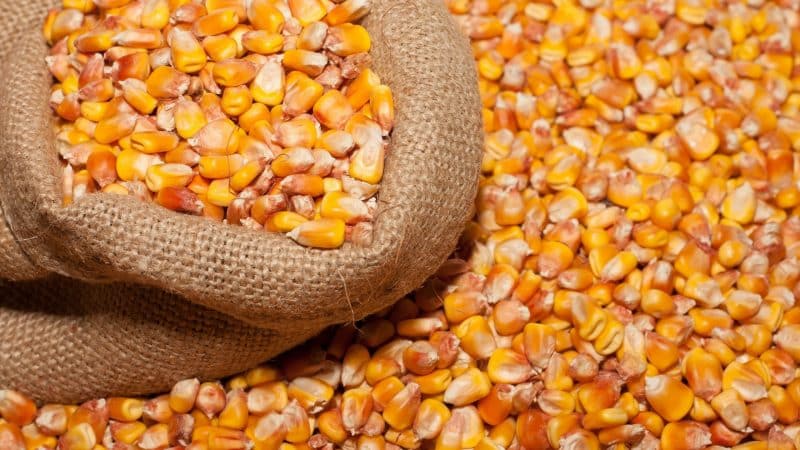
Value of corn as fodder
Corn grain based food features:
- high carbohydrate content (at least 70%);
- a large amount of fat (about 8%);
- low protein content (up to 10%).
1 kg of dry matter contains at least 15 MJ of metabolizable energy (ME). For comparison, the energy value of feed wheat is no more than 12 MJ/kg OE.
Reference. Metabolic energy is the amount of energy in feed substances absorbed after digestion. It is calculated as the difference between the energy value of the diet and energy losses through feces, urine and intestinal gases (methane).
Cereal grain is rich in vitamins (especially group B) and minerals (magnesium, sodium, iron).
This food contains essential amino acids. 1 kg contains 1.01 mg of lysine, 2.05 mg of tryptophan, 4.99 mg of tyrosine, 4.6 mg of arginine.
Animals readily eat diets based on corn grain.
How to distinguish from food
Sometimes unscrupulous manufacturers pass off cheap feed corn as more expensive food grades. A table will help you distinguish the varieties of cereals.
| Sign | Stern | Food |
| Cob shape | Thin, elongated | Thick, short |
| Color of grains of technical ripeness | Bright yellow or orange | Pale yellow, cream |
| Taste qualities | Unsweetened, tough texture even after long cooking | Tender, juicy, sweet. The grains are soft and do not require long-term heat treatment |
The photo will help you better understand the differences between forage and food plants.
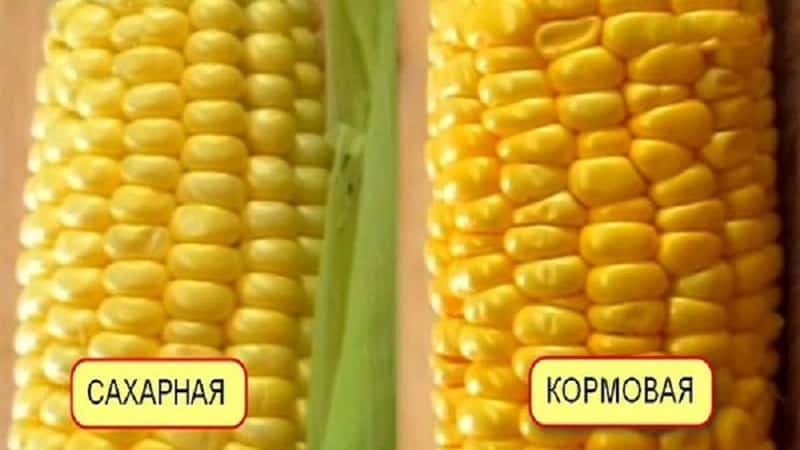
Features of cultivation and storage
Technology of cultivation, post-harvest processing and storage feed and food corn are similar.
A special feature of this forage variety is that it requires less heat and sun. Therefore, forage varieties are successfully cultivated even in northern agricultural regions.
Tillage
Corn is undemanding to its predecessors and produces good yields with proper agricultural practices, even in monoculture.
The plant prefers loose soils, so autumn plowing is carried out to a depth of 20-25 cm. In the spring, plowed soil is harrowed and as the weeds grow, they are cultivated 1-2 times. The last pre-sowing cultivation to the depth of seed placement is done simultaneously with the application of herbicides.
Fertilizer
Before plowing, potassium-phosphorus fertilizers are applied at the rate of 60-90 kg of phosphorus and 40-60 kg of potassium per hectare and rotted manure in the amount of 30-40 t/ha, as well as 30 kg/ha of nitrogen fertilizers in ammonia form.
Before the first cultivation, the soil is fed with ammonium nitrate at the rate of 20-30 kg/ha.
Sowing
Use sorted and treated seeds.Sowing of cereals begins when the seed layer of soil is warmed to +10-12 ºС. The optimal seeding depth is 6-8 cm; when planting in heavy clay soils, it is reduced to 4-5 cm. Dry weather requires increasing the sowing depth to 10-12 cm.
The row spacing should be 60-70 cm. Seed consumption varies depending on the variety, region and purpose and ranges from 10 to 25 kg per hectare.
Care
Care of crops consists of loosening, weeding, disease control and pests.
During the season, 2-3 inter-row cultivations are carried out: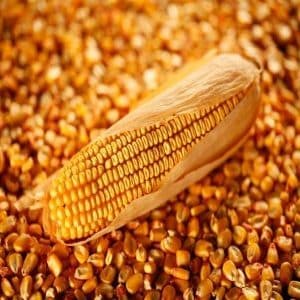
- the first - in the phase of 3-5 leaves;
- the second - after two weeks when weeds and soil crust appear;
- the latter at a plant height of 60-70 cm.
Diseases and pests are combated with protective drugs depending on the species.
Cleaning
Harvesting begins in the phase of biological maturity of the grain. The dry matter content reaches 60%, the grains acquire a bright color, the leaves and stems turn yellow. During this period, the weight of the cob is maximum.
On a note! The landmark for starting harvesting work is the appearance of a “black dot” at the base of the corn kernel.
To collect feed grain, combine harvesting with threshing of cobs using self-propelled units KSKU-6 is used.
Post-harvest grain processing
After harvesting, the corn is cleaned and sorted using air screen separators. Grain with a moisture content of less than 16% is sent for storage, while grain with a higher moisture content is sent for drying in shaft, column or bunker dryers. For feed purposes, drying is carried out at a temperature not exceeding 50 °C.
After drying, the grain must be cooled. Before filling into storage, the temperature of the corn should not exceed the ambient temperature by more than 10 °C.
Further storage
Corn grain is stored in bulk in warehouses, in elevator silos, in bunker storage facilities at a humidity of 15-16%.
During storage control temperature, humidity, color, smell, purity of the product. Particular attention is paid to the degree of infestation by pests and diseases. All listed indicators must comply with the standards of GOST R 53903-2010 “Forage corn. Technical conditions".
How to use
The use of corn as feed has its own nuances. Since the cereal is poor in proteins, it is necessary to mix in wheat or legume fodder: soybeans, peas, lupine.
Such mixtures are used for fattening pigs, poultry, and cattle.
Feeds containing corn are ideal for young animals. Due to the small amount of fiber, they are completely absorbed by the body of young animals.
There are different types of corn feed:
- canned or dried grain;
- cornflakes;
- cob flour;
- crushed grain.
Animals like corn feed and experienced farmers advise introducing it into the diet carefully to avoid digestive disorders associated with overeating.
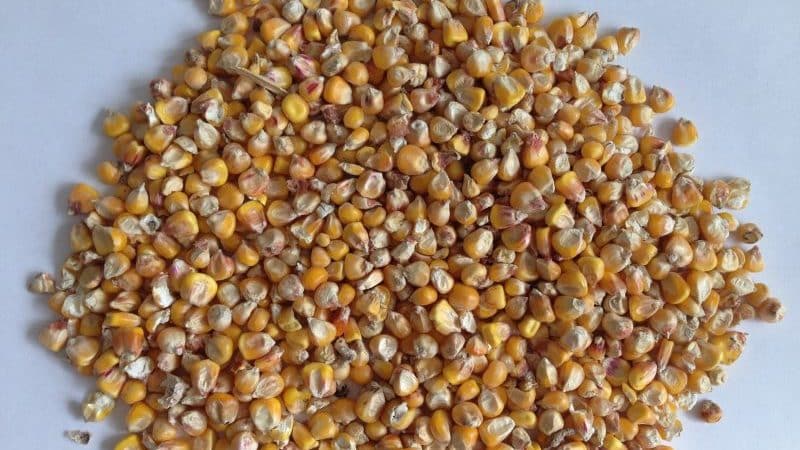
Inclusion of forage in feed composition
The use of corn forage for feeding cattle, pigs and poultry varies as different animal species have different needs.
Poultry feed
For laying hens, it is recommended to add corn grain in an amount of no more than 20%. Otherwise, there is a risk of obesity and decreased productivity.
On a note! In winter, the share of corn in the poultry diet is increased to replenish the energy spent on maintaining body temperature.
Fattening animals can be fed mixtures containing up to 40% corn feed.Gaining live weight occurs quickly and the quality of the meat does not suffer.
Is it possible to feed pigs corn?
Pig farms use up to 40% of this type of forage to speed up fattening. Be sure to combine it with high-protein feed: peas, cake, hay from legumes.
Reference. Lysine, found in large quantities in corn grains, is necessary for muscle protein synthesis and promotes rapid weight gain.
Pigs are fed only crushed grain, since their digestive juices do not digest the hard shell.
Cattle fattening
For cattle fattening, feed corn is used in various forms:
- Cob flour - These are ground corn cobs. The cobs make up about 20% of the cob's weight, so the nutritional value of this food is lower than that of the grains. Flour is used in the early stages of fattening in an amount not exceeding 50% of the total weight of the diet.
- Up to 40% of whole or crushed grains are included in highly concentrated feeds. The use of this type of forage minimizes manual labor in preparing and distributing feed.
- Corn flakes are obtained by steaming the grain for 10-15 minutes. In this case, about 50% of the starch is gelatinized, which promotes better digestibility. Flakes are used as an additive to concentrates and bulk feeds (hay, haylage, silage, stillage, fruit pomace).
Price
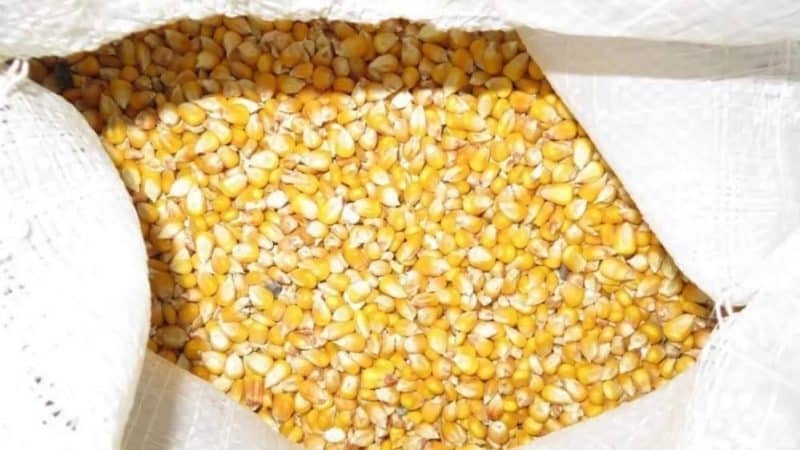
The average cost of feed corn and feed wheat depends on the class of product, region, and volume of supply.
So in the Krasnodar region you can find corn feed corn 1st class at a price of 9,000 rubles per ton.
But in the Urals, for example, in the Sverdlovsk region, the price for corn of the same quality will be from 17,000 rubles/t.For purchase volumes of 20 tons or more, suppliers will reduce the price to 11,500–12,000 rubles.
Conclusion
Feed corn is used to feed farm animals. It is used when feeding livestock in the form of whole or crushed grain, cob meal or flakes to accelerate weight gain. It differs from food in its brighter and longer cobs, the hard texture of the grains and worse taste.
This is one of the most nutritious crops, but it is used mainly in mixtures with other feeds: feed wheat, peas. Eating only corn in the diet leads to nutritional imbalances, digestive disorders in animals, obesity and decreased productivity. The average price for feed corn is generally comparable to the prices for feed wheat.